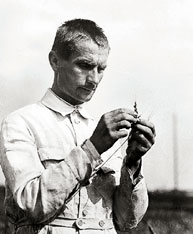The Bread Basket Case: Reflections from the Agricultural History Conference
24 June 2013 - 9:12am
 Why study history? Not a historian myself, I sometimes wonder if dwelling on the past is an upstanding profession. The Agricultural History Society conference reminded me that history, at its best, is as much about “why” as “how”. For instance: Why did the U.S. Farm Bill become a plaything of agribusiness with a few food stamps slapped on for postage? The answer to this question requires a bit of history. Because it matters when the Farm Bill and agribusiness came to exist, if the two are inseparable. (This is usually where the historian begins to preamble for a few decades, leaving the rest of us feeling fatigue.) For instance, at the conference Adam Romero presented a paper about how Shell Oil applied byproducts from the synthesis of glycerol to kill nematode lodes in Hawaiian pineapple stands in the 1940s. This predates the term agribusiness. Shane Hamilton told us how the term “agribusiness” was coined in the 1950s to help legitimize the supposedly inevitable logic of capitalist food production. Not that terms drive history. They don’t. But crops might. James Scott reminded us that while crops do not determine cultures, certain crops do tend to enable the political organization of states. Yes, grain matters. In fact, grain may matter more than atoms matter. More than political parties. Or this election or that one. Certainly more than one Farm Bill or another Farm Bill.
Why study history? Not a historian myself, I sometimes wonder if dwelling on the past is an upstanding profession. The Agricultural History Society conference reminded me that history, at its best, is as much about “why” as “how”. For instance: Why did the U.S. Farm Bill become a plaything of agribusiness with a few food stamps slapped on for postage? The answer to this question requires a bit of history. Because it matters when the Farm Bill and agribusiness came to exist, if the two are inseparable. (This is usually where the historian begins to preamble for a few decades, leaving the rest of us feeling fatigue.) For instance, at the conference Adam Romero presented a paper about how Shell Oil applied byproducts from the synthesis of glycerol to kill nematode lodes in Hawaiian pineapple stands in the 1940s. This predates the term agribusiness. Shane Hamilton told us how the term “agribusiness” was coined in the 1950s to help legitimize the supposedly inevitable logic of capitalist food production. Not that terms drive history. They don’t. But crops might. James Scott reminded us that while crops do not determine cultures, certain crops do tend to enable the political organization of states. Yes, grain matters. In fact, grain may matter more than atoms matter. More than political parties. Or this election or that one. Certainly more than one Farm Bill or another Farm Bill.
Most historians shy away from studies over a few decades or maybe a few centuries. To me, this is where agricultural history gets interesting because, say, wheat has a fine-grained history, too. It involves nation-states, political parties, famines, and genetics. We all know Norman Borlaug has won the glory of the Green Revolution for the breeding of dwarf-stature, high-response wheat. As Mark Tauger explained, the Soviets also had note-worthy agronomists breeding for the same characteristics. And the cast of characters continues after Vavilov and Lysenko. There was a man and woman named Luk’ianenko. Following the post-Stalin decline of Lysenko, the Luk’ianenko duo goes on to breed a Soviet equivalent of a Green Revolution wheat variety. This wheat produces bumper harvests for the USSR, helping avert famine. Without reliable grain yields, states suffer too. This is why telling of stories about the Farm Bill is so important. While it is convenient to type a narrative of agribusiness conspiracy and to invoke ready-made disgust for corporate greed, the State itself has a serious interest in ensuring surplus. Even if surplus storage is expensive. Sarah Phillips mentioned how persistent surpluses have structured farm politics and policy throughout the twentieth century. By the early 1960s, in fact, government storage of surplus grain was a major cost to the U.S. treasury: it was the third biggest federal expense, behind military spending and interest on the debt.
But the State won’t go on Atkins. Why? All of a sudden, discussions of agricultural history begin to be about more than farm facts and armchair accolades. I feel fatigue. Maybe this is a natural outcome of trying to interpret history. It is complex. Complex as a carbohydrate.
How do you deal with agricultural history in your classroom/museum lessons?
Photo: Trofim Lysenko, in field with wheat, Wikipedia Commons.

